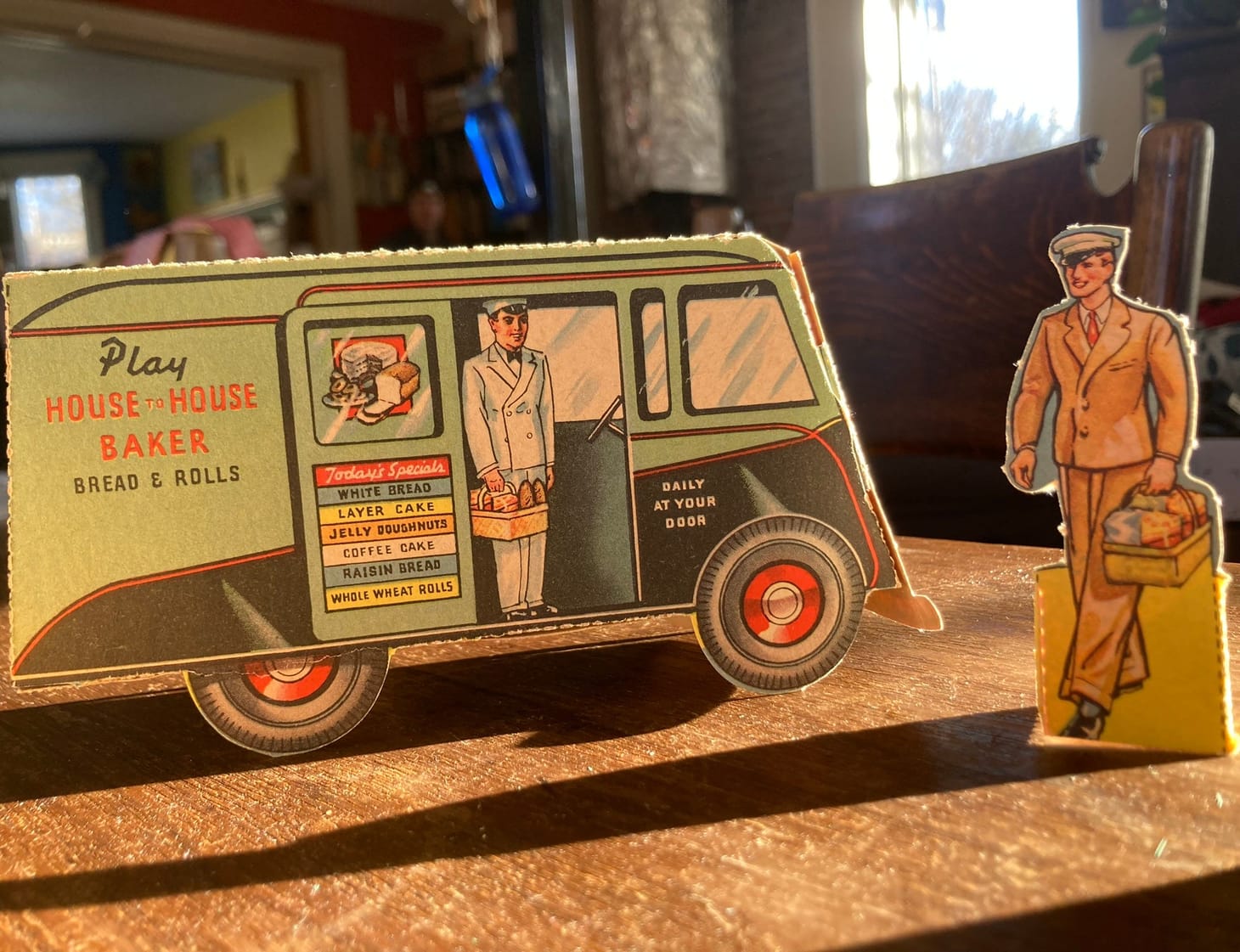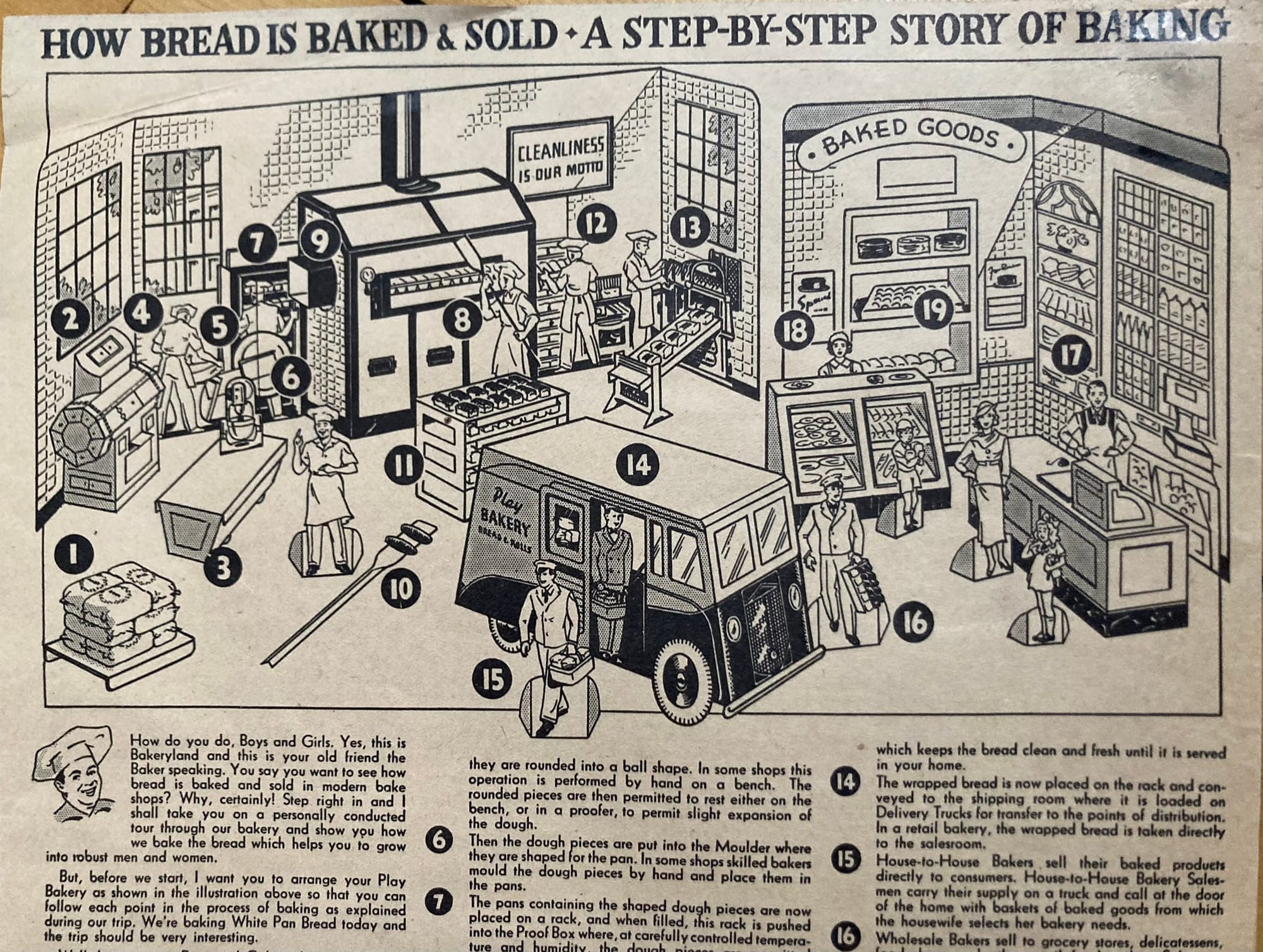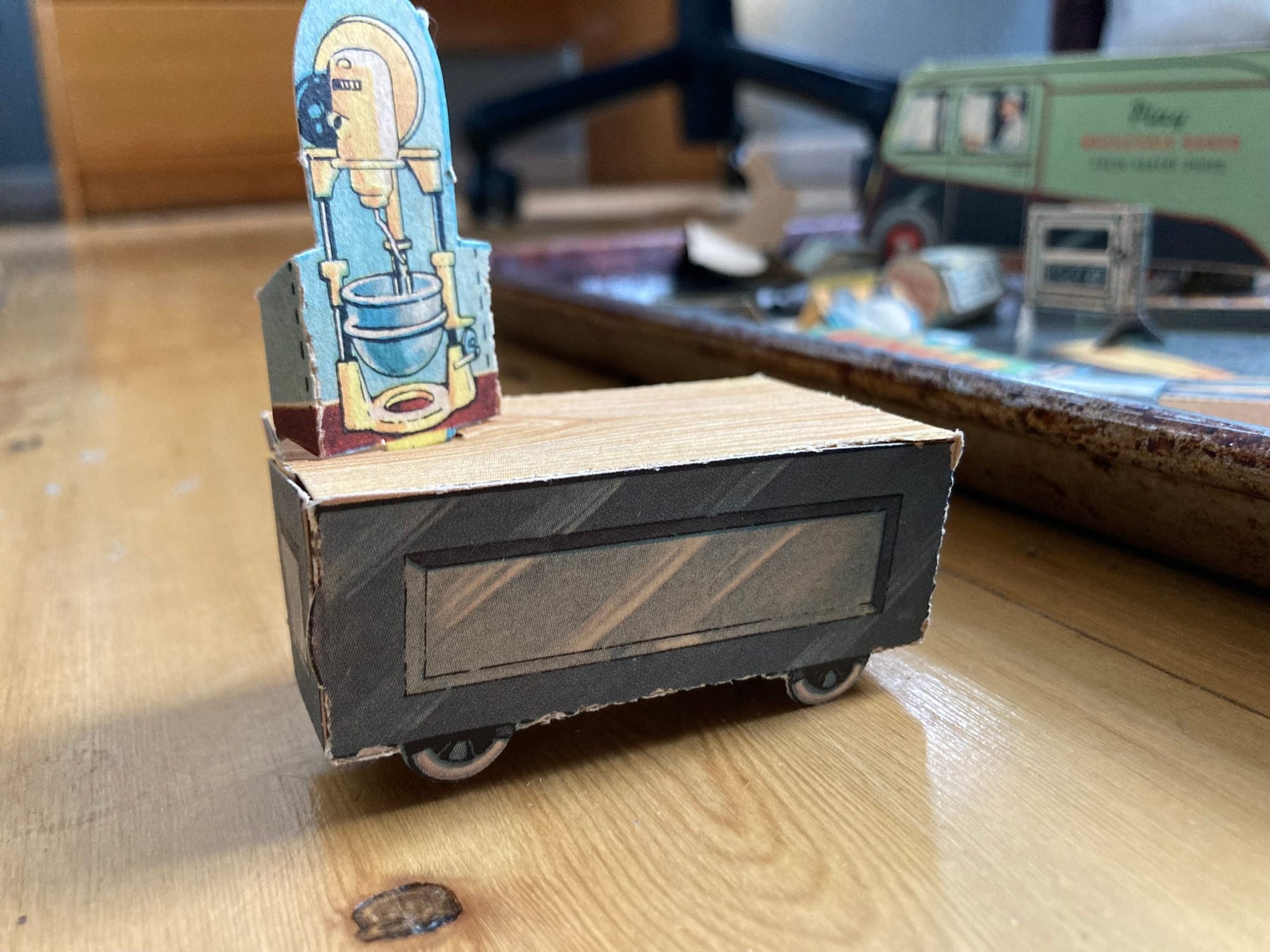Bakeryland
A game

Table of Contents
Hi there, this is just a reminder that the Flour Ambassador will be taking over Wordloaf for the winter while I am working away on my book. I’ll be popping in now and again with posts of my own, including an exciting interview with an expert on the science of starting sourdough starters next week.
I’m SUPER excited that Amy has chosen to write about her Pillsbury bread baking tabletop game for her first takeover post.
—Andrew
About a year ago, I discovered that Pillsbury once made a bakery game with paper cut-outs. I found it while poking around culinary archives online, and since serendipity is my main compass, I soon found a set for sale!
The package has sat on a shelf ever since I bought it, stuck between my ideas and its next life. Today I took it down so I can describe it to you, dear readers.
In 1936, Pillsbury made a game to teach kids about bread. Their Play Bakery Action Cut-Outs is eight pages of perforated paper dolls and bakery equipment. There’s a bakery room to kit out with flour sacks, a mixer, an oven and a bagging machine. There’s a retail bakery with shelves and a cash register, and a delivery truck. There’s also a large sheet of instructions, describing the place of bread in civilization, and describing bakery work & sales.

The book of perforated pieces was still mostly in tact, and at first, I didn’t want to disturb the status quo. I thought I’d assembled the loose parts, and leave the rest for some imaginary baking museum. But when is better than now? I realized that I can’t wait for posterity.
Putting the bakery together, I thought about its place in the world. This thing is 88 years old. My father was born in 1934, too young for the toy when hit the market. I bet the game didn’t last until my mother was old enough for it — she was born in 1938, and there’s very few copies of this floating around the vintage universe.
The game makes dioramas for baking & selling bread. The bakery is a green-tiled room, with a sign that reads ‘CLEANLINESS IS OUR MOTTO’ on the wall. The instructions guide kids through the steps of making, shaping, baking and bagging bread. I’m including them to show how 1930s era bread baking happened.

HOW BREAD IS BAKED & SOLD * A STEP-BY-STEP STORY OF BAKING
Here you see the sacks of flour which we store on skids in a clean, well ventilated, cool room until needed.
When the baker starts to make bread, the flour and other dry ingredients are sifted and carefully weighed. The sifted ingredients are then placed in the Mixer, the water and liquid ingredients added and the machine thoroughly mixes the ingredients and kneads the dough. Bakers call this process “Developing the dough.”
After the dough is properly mixed and developed, it is turned out into a Trough where it is allowed to ferment (rise) under carefully controlled conditions of time, temperature, and humidity.
When the dough is properly fermented (an interval of several hours) it is removed from the Trough and placed in the Divider where it is cut into pieces of given size. In some shops the dough is cut and weighed by hand on a bench, or on a cover placed over the Trough.
The cut pieces of dough then go to the Rounder where they are rounded into a ball shape. In some shops this operation is performed by hand on a bench. The rounded pieces are then permitted to rest either on the bench, or in a proofer, to permit slight expansion of the dough.

A mixer on top a trough on wheels, with the wooden bench placed on top. Then the dough pieces are put into the Moulder where they are shaped for the pan. In some shops skilled bakers mould the dough pieces by hand and place them in the pans.
The pans containing the shaped dough pieces are now placed on a rack, and when filled, this rack is pushed into the Proof Box where, at carefully controlled temperature and humidity, the dough pieces are permitted to rise again in the pans.
When the dough is properly proofed, the rack is removed from the proof box after which the baker puts the pans on a Peel and places them in the oven to bake.
In the mechanical-type Oven, the pans of dough are placed directly on the moving oven hearth without the aid of a Peel. (The moveable hearth shows the bread while it is being baked in the oven.)
Some types of bread (“Hearth breads”), such as rye, French, Vienna, rolls, etc., are not baked in pans but are loaded directly onto the hearth of the oven by means of the Peel and removed in the same manner.

The oven has a rotating rack of bread in various stages of baking. There’s also a peel, and loaves of rye bread to load on the hearth. After the bread is properly baked, the pans are removed from the oven by means of the Peel (or with gloved hands) and the bread is taken out of the pans and placed on a Rack to cool. In some shops, these racks are placed in temperature-controlled coolers.
When the bread has cooled sufficiently, it is removed from the rack and put through a Slicing Machine which slices the entire loaf in one operation.
After being sliced, the loaf now passes to the Bread Wrapper where it is wrapped in clean, attractive paper which keeps the bread clean and fresh until it is served in your home.
The wrapped bred is now placed on the rack and conveyed to the shipping room where it is loaded on Delivery Trucks for transfer to the points of distribution. In a retail bakery, the wrapped bread is taken directly to the salesroom.
House-to-House Bakers sell their baked products directly to consumers. House-to-House Bakery Salesmen carry their supply on a truck and call at the door of the home with baskets of baked goods from which the housewife selects her bakery needs.
Wholesale Bakers sell to grocery stores, delicatessens, food shops and other retail food outlets. Sales are made from the Truck and the men who distribute baked goods in this manner are known as Wholesale Bakery Salesmen.
In retail food establishments such as grocery stores and delicatessen stores, the selling is done over the counter by the Proprietor and clerks. Freshly baked goods are delivered to these stores daily by the Wholesale Bakery Salesmen.
In Retail Bakery Stores, most of the selling is done by salesgirls who, in order to serve the customer properly, are specially trained for this kind of work. The workroom where the Baking is done is usually in the same building.
To help you in the selection of your bakery needs, modern bakers display their wares in clean, neat, specially designed show cases, on tables and counters, and in attractive wall cases.
And now, Boys and Girls, our trip through Bakeryland is ended. When you play with your Play Bakery, try to remember some of the interesting facts I have told youa bout modern commercial baking — one of our oldest and most essential industries.
THE BAKER

The game offers scripts for how to sell bread in wholesale, retail, and house-to-house settings. The Wholesale Baker script takes place between the Grocer and Customer, and the grocer is a man while the customer is a married woman. Throughout the game, men are the workers and women are the customers, except for the retail bakery clerk, or ‘salesgirl.’
LITTLE LESSONS IN SALESMANSHIP
Use This When You Play House-to-House Baker
Salesman: Good morning! You are new in this neighborhood?
Customer: Yes! I’m Mrs. Rollins. We’ve just moved here from out of town.
Salesman: How do you do, Mrs. Rollins. I’m here to offer delicious and tasty foods for every meal of the day. Special breads, doughnuts, cakes, cookies. Something new and different all the time.
Customer: Splendid! I want some rolls for breakfast tomorrow. We like variety at our house and when I can buy so many nice things from you it really doesn’t pay to try to bake them myself.
Salesman: That’s right, Mrs. Rollins. I’ll be at your door each day with my basket of fresh tasty baked goods. Goodbye.
When I first got the game I was dismayed to see options for girls and women so narrowly represented. I thought that it was advertising the profession of baking to kids, and felt annoyed to see limits for women. After ‘playing’ with the game, I now think its job was not to suggest career possibilities. Sure, it describes the work of baking and selling, but I think the main task was to sell the idea of buying bread.

The game can be seen as part of a propaganda campaign that the baking industry began decades earlier. At the turn of the 20th century, the emerging trade identified housewives as their main competition, and sought to convince America’s primary bread providers they should be buying, not baking. A 1911 pamphlet, “The Story of the Staff of Life,” produced by the National Association of Master Bakers argued for ‘bakers bread,’ as opposed to homemade because it surpassed, in sanitation & nutrition, what could be made at home. (I wrote about this for Wordloaf a couple of years ago, and the images are well worth a look.)
This game continues to argue for buying bread, but I can’t lump it into one long anti-homemade bread cry from the profession. For one, it was not made by a bakery trade organization, but a flour company, which was invested in selling bread’s primary ingredient to home bakers as well as bakeries. And for another reason, the landscape of bread baking in America changed vastly in the 25 years between “The Story of the Staff of Life” and Pillsbury’s Play Bakery.
During the 1910s and 1920s, ‘bakers bread’ and factory bakeries became common, and outpaced home baking. Factories consolidated into monopoly ownership that ran into trust-busting lawsuits, and less bread was baked at home than purchased. Then, the Great Depression happened, swinging the pendulum of industry growth backward, and sending women back to baking their own bread and treats. Between 1929 and 1933, according to the U.S. Census of Manufactures, the number of bakeries dropped by 5580.1 My great uncle George’s bakery in Cohoes, New York was one that didn’t survive the times.

Put in this context, the game was reasserting the necessity of a product Americans had grown used to buying, but couldn’t afford. There’s so much more I need to know to really understand the place of this game, but that is my preliminary report.
Now, it’s your turn. Let’s talk about any bakery games you’ve played — video, card, board? I see that Pillsbury’s Popping Fresh had a board game in the 1960s — did anyone play that?
Yours, Amy
Panschar, W.G. and Slater, C.C. (1956) Baking in America. Evanston, IL: Northwestern University Press. ↩
wordloaf Newsletter
Join the newsletter to receive the latest updates in your inbox.



